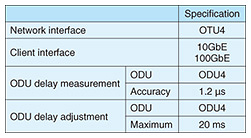 |
|
|
|
|
|
Feature Articles: Launch of APN IOWN1.0 Service Vol. 21, No. 9, pp. 32–36, Sept. 2023. https://doi.org/10.53829/ntr202309fa4 Delay Managed Network for APN IOWN1.0AbstractThis article introduces the concept of the Delay Managed Network to control communication latency and the optical transport network (OTN) equipment, called OTN Anywhere, which has delay-measurement and delay-adjustment functionalities. NTT operating companies, NTT EAST and NTT WEST, released the first-version service of the All-Photonics Network (APN) of the Innovative Optical and Wireless Network (IOWN), APN IOWN1.0, in March 2023 that is based on OTN Anywhere. In addition to the benefit of low latency approaching the physical limit, this service provides end-to-end layer-1 paths without latency fluctuation and offers delay measurement and delay adjustment of each end-to-end layer-1 path. The Delay Managed Network can enhance user experience of various remote activities. Keywords: IOWN, All-Photonics Network (APN), Delay Managed Network 1. Importance of low-latency communicationWith the rapid advances in communication technologies, the number of remote activities based on sophisticated communication services is increasing. This trend has been accelerated due to the drastic lifestyle change caused by the COVID-19 pandemic. Such remote activities include conventional video streaming based on one-way communication as well as interactive video and voice streaming based on bi-directional communication. Figure 1 shows a nation-wide remote e-sports competition across multiple cities as an example of such remote activities. Communication latency is extremely important because instantaneous response is a critical component of players’ user experience (UX) while playing games. Communication latency differs depending on players’ location and can fluctuate due to network congestion. This unfair communication environment is a critical problem in supporting remote e-sports competitions across multiple cities, especially professional e-sports games. Therefore, very low latency and fair communication environments are critical for use cases such as e-sports.
A next-generation communication service with low latency and latency manageability will play a key role in e-sports as well as live-entertainment, remote collaboration, and up-and-coming XR (cross reality) and the metaverse. Given this situation, we have investigated networking technologies that can enable the flexible control of communication latency. 2. Concept of Delay Managed NetworkWe have created a new networking concept, the Delay Managed Network, to drive the UX revolution on the basis of advanced layer-1 networking technologies. It has the following three major features (also illustrated in Fig. 2).
(1) Providing end-to-end layer-1 paths The Internet is an indispensable part of daily life, and its importance will continue to increase. However, its best-effort nature sometimes causes undesirable situations, for example, sudden increases in communication latency, capacity loss, and possible loss of packets due to network congestion. These problems significantly degrade UX in many use cases. Given these considerations, we want to make it possible to provide communication services that do not have such a limitation. In other words, we want to offer end-to-end layer-1 paths, which feature low absolute latency, zero-latency fluctuation, and predetermined capacity, even in the face of network congestion. (2) Measuring and adjusting communication latency Given the increased importance of low-latency communication, we want to create paths that offer latency that is as low as possible as well as delay-measurement and delay-adjustment functionalities to provide unprecedented UX. From the viewpoint of end users, delay measurements of only the links the communication path uses might be meaningless, so we have to provide the means to measure and adjust end-to-end latency along the path. If we use a communication protocol that inherently has latency fluctuation, delay measurements will be ineffective because latency constantly changes. Given this consideration, it is important to use a communication protocol that has no latency fluctuation. (3) Accommodating various client signals The Delay Managed Network has to accommodate various client signals from end users to support various use cases. In addition to Ethernet, which is widely used, the Delay Managed Network should support various client signals such as video and voice. 3. Enabling technologies for IOWN1.0We developed an optical transport network (OTN) equipment called OTN Anywhere to enable the features of the Delay Managed Network (Fig. 3).
OTN Anywhere is basically connected to the edge of the All-Photonics Network (APN) and used in combination with metro/long-haul transport equipment such as dense wavelength division multiplexing (DWDM) transmission systems. OTN Anywhere can be connected to various transmission systems worldwide via the standard interface of the optical transport unit 4 (OTU4), which is specified in the OTN (Optical Transport Network) standards of International Telecommunication Union - Telecommunication Standardization Sector (ITU-T). A layer-1 communication path, called the optical data unit (ODU) path, between OTN Anywhere is transparently transported by DWDM transmission systems, so OTN Anywhere can be implemented regardless of the type of DWDM transmission system used. OTN Anywhere can be installed at customer premises and directly transfer user signals into the OTN. OTN Anywhere also has our newly developed delay-measurement and delay-adjustment functionalities. Table 1 lists the specifications, and Figure 4 shows the appearance of OTN Anywhere.
OTN Anywhere has the following technologies in regard to the three features described in Section 2. (1) Providing end-to-end layer-1 paths We use the OTN protocol for OTN Anywhere. The OTN is widely used as a backbone infrastructure in metro/long-haul networks worldwide. The OTN protocol offers 100% capacity guarantee, low latency approaching the physical limit, and no latency fluctuation. While end users merely see the protocol, we have developed OTN Anywhere as a one-rack-unit equipment, which can be installed at customer premises to provide genuine end-to-end layer-1 communication paths. OTN Anywhere can dedicate an end-to-end ODU path to the user, as shown in Fig. 3. ODU paths can be multiplexed into higher-rate ODUs without affecting other users’ traffic. This enables the efficient use of lambda capacity when one user does not use the full capacity of a wavelength. (2) Measuring and adjusting communication latency OTN Anywhere provides delay-measurement and delay-adjustment functionalities for end-to-end ODU paths. The delay-measurement function is for measuring round-trip delay in micro-second accuracy. At one end of the ODU path, OTN Anywhere adds delay-measurement bits, which then traverse the ODU path, to be loop-backed at the other end of the ODU path and reach the original end point (Fig. 5). This function is compliant with the delay measurement specified in ITU-T Recommendation G.709. It is still difficult to measure end-to-end round-trip delay from the viewpoint of the end user because the OTN protocol is used only in the backbone network, not end-to-end. As OTN Anywhere measures the round-trip delay, it enables end-to-end measurement.
In addition to delay measurement, OTN Anywhere can offer delay adjustment if needed (Fig. 5). The delay-adjustment function has two operation modes: instantaneous delay adjustment and hitless delay adjustment. The instantaneous-delay-adjustment mode adjusts the delay of the ODU path via short-hit, which means that bit errors are observed during adjustment. This mode is useful, for example, for drastic delay adjustment before ODU-path activation. The hitless-delay-adjustment mode adjusts the delay of the ODU path without short-hit, which means that no bit errors are observed during adjustment. This function is useful for fine-tuning delay under the in-service condition. These two functionalities, delay measurement and delay adjustment, enable the flexible control of communication latency. They are implemented in layer 1 and independent from upper-layer protocols, so they support many use cases. (3) Accommodating various client signals OTN Anywhere currently supports one of the most major client signals, Ethernet (10GbE/100GbE). This means that it is possible to transport Ethernet as well as various video and voice signals by combining off-the-shelf products. These video and voice signals are mapped into the OTN via Ethernet, but as there is no Ethernet switch along the ODU path, no significant latency increase or fluctuation increase occurs. OTN Anywhere can measure and adjust the latency of the ODU path. Measured latency values can be passed, for example, to other systems, servers, or operators. These measured delay values support real-time processing, server processing, or latency-sensitive operation. In remote e-sports competition among multiple cities, the communication latency of each venue is first measured, then the delay of each venue is set to be the same to create fair competition. 4. Perspectives on OTN Anywhere evolutionWe have just taken the first step of APN IOWN1.0 by developing OTN Anywhere. We plan to evolve the APN by continuously creating new functionalities and technical innovations. The direction of OTN Anywhere evolution includes supporting various consumer and legacy signals, adding new functionalities such as path protection, and providing economical connections to the APN. We are making efforts to create innovations on the basis of potential customer needs and plan to offer unprecedented UX to each customer in the near future. |
|






















